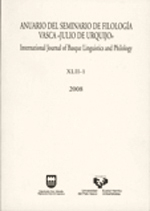La balada «Urthubiako alhaba»: Problemas y conjeturas
##plugins.themes.bootstrap3.article.main##
##plugins.themes.bootstrap3.article.sidebar##
Laburpena
The oral ballad Urthubiako Alhaba was published by Julien Vinson in 1884, from an original manuscript. The text, which could date back to a c. 1830 recitation, was considered unauthentic by Vinson, an opinion that has remained in the studies regarding Basque ballads till nowadays. This negative opinion has been strengthened during the last two decades (1990 and 2000), since it has been included among the falsifications attributed to Garay de Monglave, an author known for his falsifications. This last judgement is, no doubt, erroneous: we can be sure that the text comes from Jean Baptiste Archu, a well-known translator and grammarian in Basque studies, besides being a reliable collector of folksongs.
The personality of the collector and the internal analysis of the text (expressions, style, metrics) allow us to argue that Urthubiako Alhaba is an authentic traditional ballad, thus invalidating Vinson's opinion, an opinion based on his prejudice regarding the lack of "originality" in Basque culture, and by the generalized suspicion due to the long amount of fake historical songs spread throughout the XIXth century.
The ballad is particularly valuable, since it would be the earliest attested in Basque popular tradition; it also would represent an archaic model of oral narrative poem, which became extinct between XVIII and XIX centuries and was characterized by a run of monorhyme tirades and anisosyllabism.
The tragic content of the ballad seems to have its basis in a legend about the lineage of the lords of Urthubia; more precisely, in a shady incident which happened in 1564: the imprisionment and death of Juan de Alzate and his wife, Ana de Ezpeleta, accused of the crime of lese majesty, and taken to Paris by order of King Henry II of France.
Nola aipatu
##plugins.themes.bootstrap3.article.details##
Lan hau Creative Commons Aitortu-EzKomertziala-LanEratorririkGabe 4.0 Nazioartekoa lizentzia baten mende dago.


